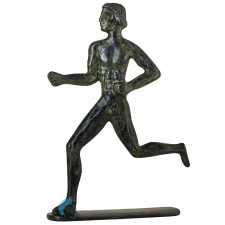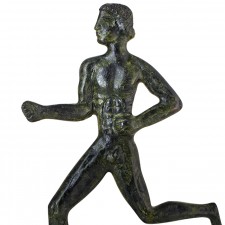Δρομέας Λεπτός
Ορειχάλκινος δρομέας.
Χειροποίητο ορειχάλκινο γλυπτό, με εγγύηση ποιότητας. Παραδοσιακά φτιαγμένο με τη μέθοδο χύτευσης μετάλλου και με οξείδωση παρόμοια με του μουσείου.
Με την πάροδο του χρόνου, ο θεσμός της Ολυμπιακής εκεχειρίας και των Ολυμπιακών αγώνων έγιναν όλο και πιο δημοφιλής σε όλο τον Ελλαδικό χώρο. Ενώ αρχικά στους αγώνες έπαιρναν μέρος μόνο κάτοικοι της Ήλιδας, σταδιακά διευρύνθηκε ο κανονισμός, ώστε να επιτρέπονται αθλητές από την Αρκαδία, την Λακεδαίμονα και την Μεσσηνία, ακόμα και από όλη την Πελοπόννησο και τα Μέγαρα. Ακολούθησαν οι εκτός Πελοποννήσου πόλεις των Αθηνών και της Ιωνίας. Μέχρι τον 4ο αι. μ.Χ. όπου και σημειώνεται το τέλος των Ολυμπιακών αγώνων, η συρροή των αθλητών από όλα τα μέρη ήταν μεγάλη. Από τις Αποικίες στην Σικελία και την Μικρά Ασία, την Ρόδο, από την Αίγυπτο (ιδίως την Αλεξάνδρεια), την Κυρήνη και την Φοινίκη, αλλά και από την Ρωμαϊκή αυτοκρατορία έρχονταν αθλητές για να αγωνιστούν στην Ολυμπία. Τελευταίος Ολυμπιονίκης ήταν ο Αρμένιος Αρσακιάδης Artavazd (ή Varaztad).
Από την 37η Ολυμπιάδα (632 π.Χ.) αρχίζουν να παίρνουν μέρος έφηβοι. Ο έφηβος Δαμίσκος από την Μεσσηνία κερδίζει στην 103η Ολυμπιάδα (368 π.Χ.) τον αγώνα δρόμου σε ηλικία δώδεκα ετών.
Η παρακολούθηση των αγώνων επιτρεπόταν σε όλους, ελεύθερους και δούλους, ακόμα και βάρβαρους. Μονάχα απαγορευόταν αυστηρά στις γυναίκες, ίσως γιατί ορισμένοι αθλητές αγωνίζονταν γυμνοί. Για όποια μάλιστα τολμούσε να παραβεί τη διαταγή αυτή, υπήρχε η ποινή του θανάτου. Ωστόσο, μία γυναίκα που ανήκε σε σπουδαία αθλητική οικογένεια και λαχταρούσε να καμαρώσει νικητές μέσα στο στάδιο τους δικούς της, δε δίστασε να ντυθεί άντρας και να περάσει μέσα στους θεατές των αγώνων. Ήταν η Καλλιπάτειρα, κόρη του περίφημου Ρόδιου Ολυμπιονίκη Διαγόρα, αδελφή και μητέρα επίσης νικητών στις Ολυμπιάδες. Αυτή ακριβώς η συγγένειά της με ξεχωριστούς αθλητές έκανε ίσως τους Ελλανοδίκες να της συγχωρήσουνε την παράβαση και να της επιτρέψουνε τιμητικά να παρακολουθήσει τους αγώνες.
Επίσης σημειώνεται μεμονωμένα και τίμηση γυναικών, πράγμα που δεν ήταν σύνηθες φαινόμενο, αφού η συμμετοχή ήταν καθαρά ανδρικό προνόμιο. Στα ιππικά αθλήματα της αρματοδρομίας και της ιππασίας όμως το βραβείο πήγαινε στον ιδιοκτήτη του αλόγου, που δεν ήταν αναγκαστικά ο ίδιος ο ιππέας που έπαιρνε μέρος. Έτσι έχουμε την Σπαρτιάτιδα Κυνίσκα, θυγατέρα του Αρχίδαμου και αδερφή του Αγησίλαου, που τιμήθηκε με το κλαδί ελιάς και στην οποία έκτισαν ηρώο και αφιέρωσαν ανδριάντες.
Συχνά μπορούσε κάποιος ν' ανακηρυχθεί Ολυμπιονίκης χωρίς να αγωνιστεί έγκαιρα στο στάδιο ή δίσταζε να λάβει μέρος από φόβο μη νικηθεί. Τέλος, σε περίπτωση που ο αριθμός των αγωνιστών σε κάποιο άθλημα ήτανε περιττός, απόμενε μετά την κλήρωση των ζευγαριών ένας αθλητής που λεγόταν έφεδρος. Αυτός περίμενε με ακμαίες τις σωματικές του δυνάμεις να συναγωνιστεί μ' εκείνον που ύστερα από αλλεπάλληλους αγώνες θα είχε καταβάλει τους άριστους από κάθε ζεύγος αθλητών.
Διαβάστε περισσότερα εδώ
| Λεπτομέρειες | |
| Ύψος | 13cm |
| Βάρος | 300g |
| Υλικό | Ορειχάλκινο |



